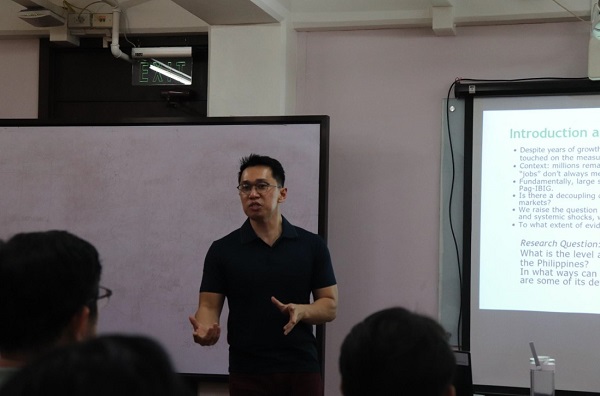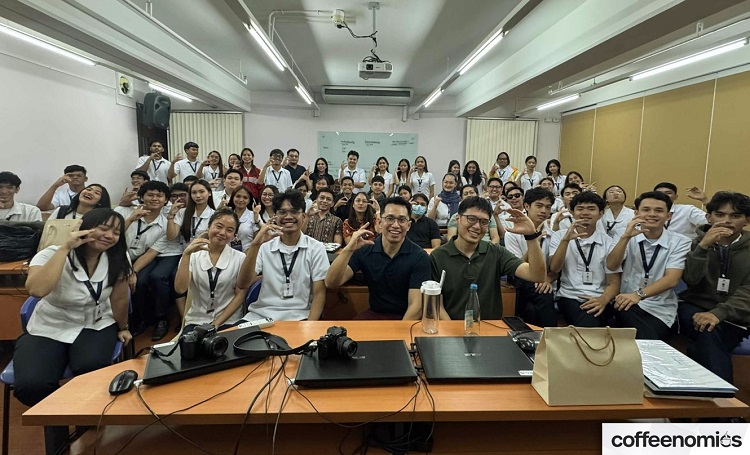By Allison March Dy and Jayzel Bangot
The Philippines has maintained steady economic growth over the past decade, but this apparent progress hides deep and persistent weaknesses in job quality. While more Filipinos are employed today, many continue to work in unstable, low-paying, and unprotected jobs. Behind the country’s expanding GDP lies an important question: How secure are the jobs that Filipinos actually hold?
This concern became the main topic of discussion at a recent session of Coffeenomics, a forum series organized by the Department of Economics, Xavier University Ateneo de Cagayan. The guest speaker, Dr Jason Alinsunurin, Associate Dean and Associate Professor at the Carlos L. Tiu School of Economics, De La Salle University, presented his study “Measuring Labor Market Vulnerability in Transition: Introducing a Multidimensional Job Precarity Index for the Philippines.” His research provides a data-driven examination of job insecurity in the country and introduces a comprehensive way to assess labor market vulnerability.

Dr Jason Alinsunuriin, Associate Dean and Associate Professor of De La Salle University, Carlos L Tiu School of Economics
Photos by Christian Josh Abuso, Kaye Bañas, Ahlaizar Daquio
Dr Alinsunurin’s work uses data from the Philippine Labor Force Survey (LFS) to construct the Precarity Employment Index (PEI), a multidimensional tool that captures five aspects of job insecurity: short-term or non-permanent contracts, irregular or inconsistent pay, self-employment or unpaid family work, multiple jobholding, and underemployment. By combining these indicators, the PEI reveals that employment in the Philippines is not only unevenly distributed but also structurally precarious.
The study reveals that more than half of Filipino workers, about 55 to 59 percent, receive irregular pay, and nearly 30 percent hold short-term contracts. These figures suggest that job instability is a fundamental feature of the labor market, not a temporary byproduct of crises. During the COVID-19 pandemic, underemployment rose sharply, and more workers took on multiple jobs as a coping mechanism, evidence that even those counted as employed remain vulnerable to economic shocks.

Photos by Christian Josh Abuso, Kaye Bañas, Ahlaizar Daquio
Sectoral analysis shows clear contrasts across industries. Agriculture stands out as the most precarious, with work often characterized by self-employment, unpaid family labor, and irregular pay. Manufacturing appears to offer the most stability, while the services sector sits in between, with flexible yet insecure contractual arrangements.
Education, according to Dr Alinsunurin, is a key shield against precarity. Workers with higher educational attainment, particularly those with college or technical-vocational training, tend to face lower risks of irregular pay and temporary employment. Meanwhile, those with only elementary or secondary education remain the most vulnerable. This education gap reinforces the need for stronger public investment in schooling, technical skills, and lifelong learning.
The study also highlights gender differences in job vulnerability. Women are more likely to be employed under short-term contracts and precarious arrangements but less likely to engage in multiple jobholding or face irregular pay. These patterns point to the importance of gender-sensitive labor policies that promote equal treatment, predictable work hours, and improved childcare access.
Beyond diagnosing the problem, Dr Alinsunurin’s study also offers policy directions. He emphasizes that tackling job precarity requires a shift from simply generating jobs to ensuring job quality. This includes strengthening education and re-skilling programs, expanding social protection, formalizing informal work, and enforcing fair labor standards across all sectors.

Photos by Christian Josh Abuso, Kaye Bañas, Ahlaizar Daquio
As a forward-looking proposal, the research introduces the idea of combining the Precarity Employment Index (PEI) with a Social Protection Deficit Index (SPDI) to create a Multidimensional Precarity Index (MPI). This framework would allow policymakers to monitor labor vulnerability more precisely and to design interventions grounded in measurable data.
By framing labor precarity as a measurable and multidimensional issue, Dr Alinsunurin’s study pushes the conversation beyond employment rates and toward the quality and security of work. His session ended with a clear reminder: true progress is not only about economic growth, but about ensuring that every Filipino worker has stable, secure, and dignified work. Sustainable development means leaving no one behind, especially the people who make up the backbone of the economy.